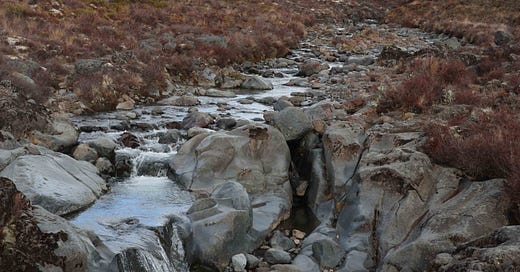The snow of Mount Ruapehu shines so white that even the clouds which cling to the broad peak look dirty. The chill mountain air refreshes me, the flickering of light on the stream mesmerises me, the song of water on stone soothes me. I’m standing on a bridge above a mountain stream, and it strikes me that this must be some of the purest water in the North Island. It has melted from that celestial snow above and flowed through tussocks and shrubland free from buildings, roads, industries, sewage outflows, livestock, fertiliser, forestry periodically stripping the land and the myriad human activities which pollute our waters. I know that somewhere above me, there is a skifield, so it’s not entirely free from human touch. Still, the water which flows under this bridge is something special.
The pure snow of Ruapehu is the source of the North Island’s two mightiest rivers, the Waikato and the Whanganui. Neither manages to maintain the sparkling clarity of their headwaters. There are stories about them which I want to uncover, but I’m not going to do that standing on a bridge in the Tongariro National Park. I’m simply going to enjoy what I’ve come to see, the water, the shrubland and the forest.
I turn around and watch the water flowing away from me. I see that the land drops away – I realise I’m looking at the top of the Taranaki Falls, the reason this particular track is here. I can’t tell the size of the drop, but there’s a good flow of water. I’m sure that the falls will be spectacular.
So far I’ve been walking in sub-alpine shrubland. It’s a type of vegetation which grows higher up mountains than forest, but often below the alpine grassland. If there wasn’t a track, it would be brutal to walk through. I’ve done it before, in more remote mountain areas, and every step is a struggle. The main species is a native dracophyllum, which has needle-like leaves a few centimetres long. The leaves aren’t sharp, but they are slippery. Negotiating a patch is an uncomfortable compromise between pushing through them and walking on top of them.
Today, though, I’m on a perfectly good track, and I’m grateful. The only niggle in my mind is a small straggly plant growing among the native shrubs. It’s heather, transplanted from Scotland, along with the game bird, grouse, by someone with aspirations to recreate the estates of the wealthy on the other side of the world. The grouse didn’t survive, but the heather did only too well.
After the bridge, the track heads downhill and the shrubland turns into forest. It’s mountain beech, a low canopy of twisted trees growing at the limit of what they can survive. Climate change crosses my mind. As temperatures warm, treelines will rise, a line of green creeping up the mountains. It may squeeze out some of our native alpine plants, those which grow above the treeline, as their habitat moves higher and higher. It’s another thing I tuck away in the back of my mind, something I want to research more.
I walk down a set of steep steps, then come around a corner and into shrubland again. I hear the rush of the falls. There’s a twenty metre drop, and the water isn’t simply trickling over the edge. It pours through a narrow gap and the force of the flow carries it into a graceful arc before it falls into a pool below. I stand and watch for a while, and I would stay longer but the air is cold and it’s late in the day. So I follow the course of the stream to another bridge and the second part of the falls. The water takes a sharp bend where it has gouged a smooth indentation in the rock and plunges into a deep gorge. The water is so clear I can see the texture of the rock. But the pleasure is marred by a chip packet which someone has dropped. It’s caught in part of a tree branch below me, out of reach.





